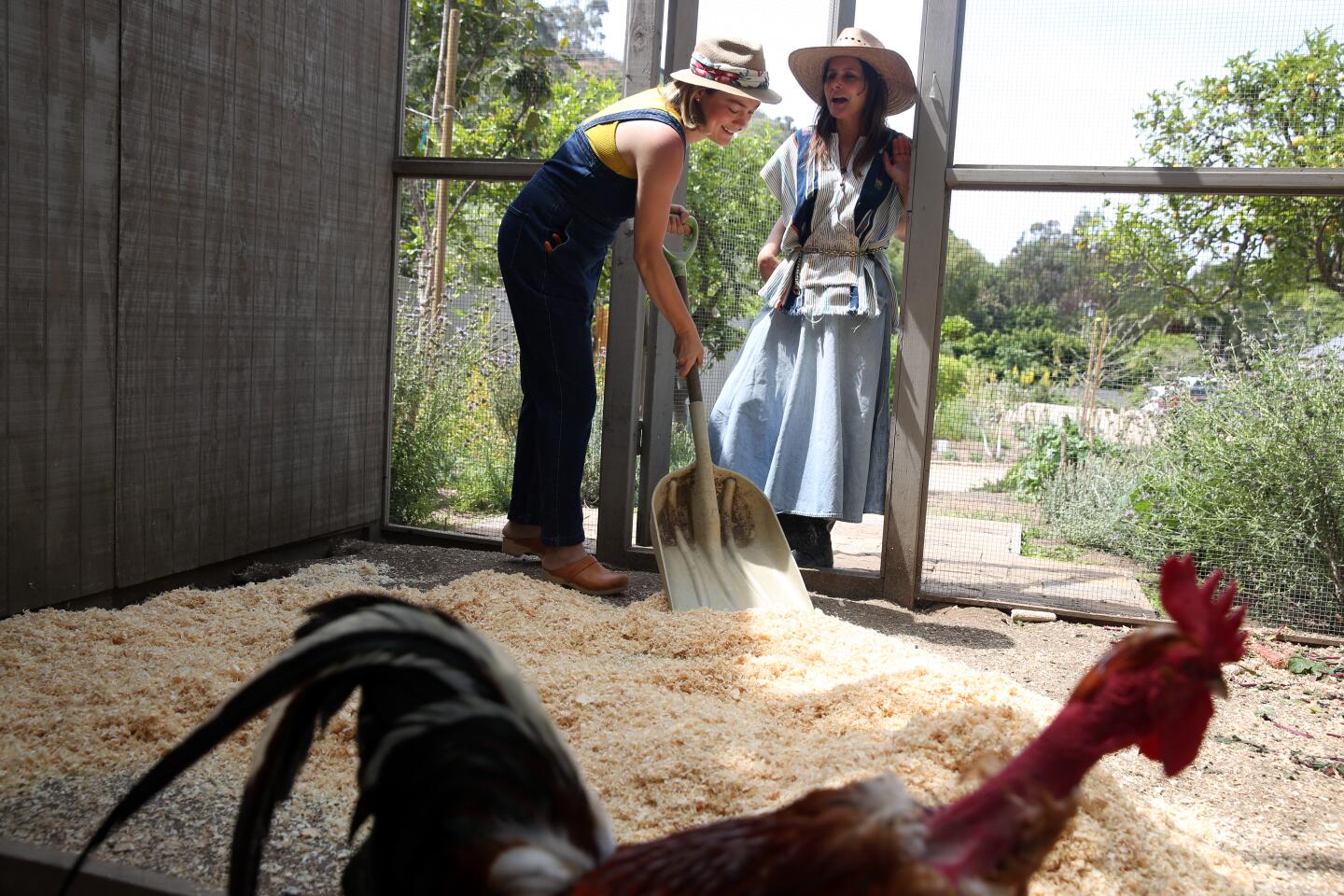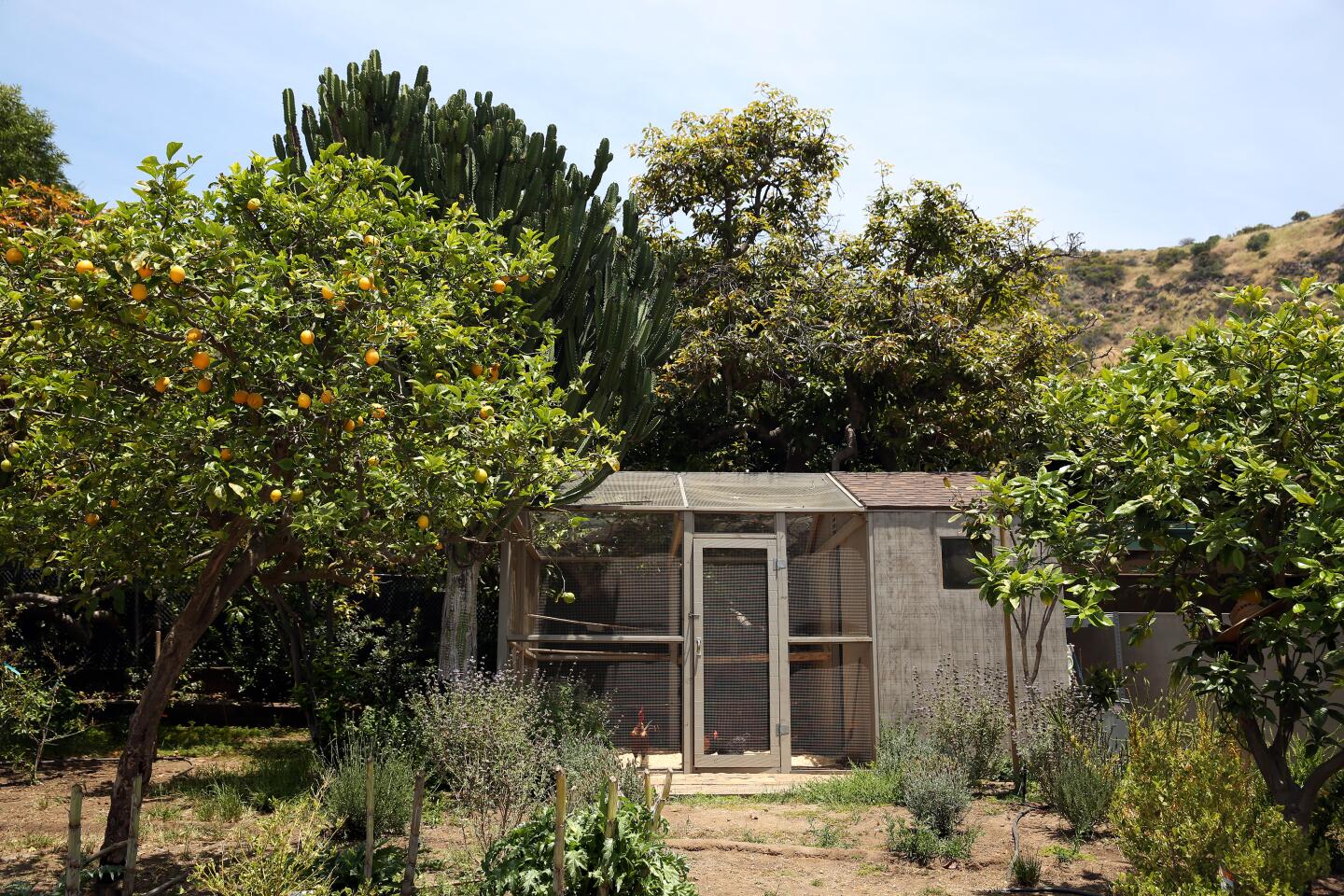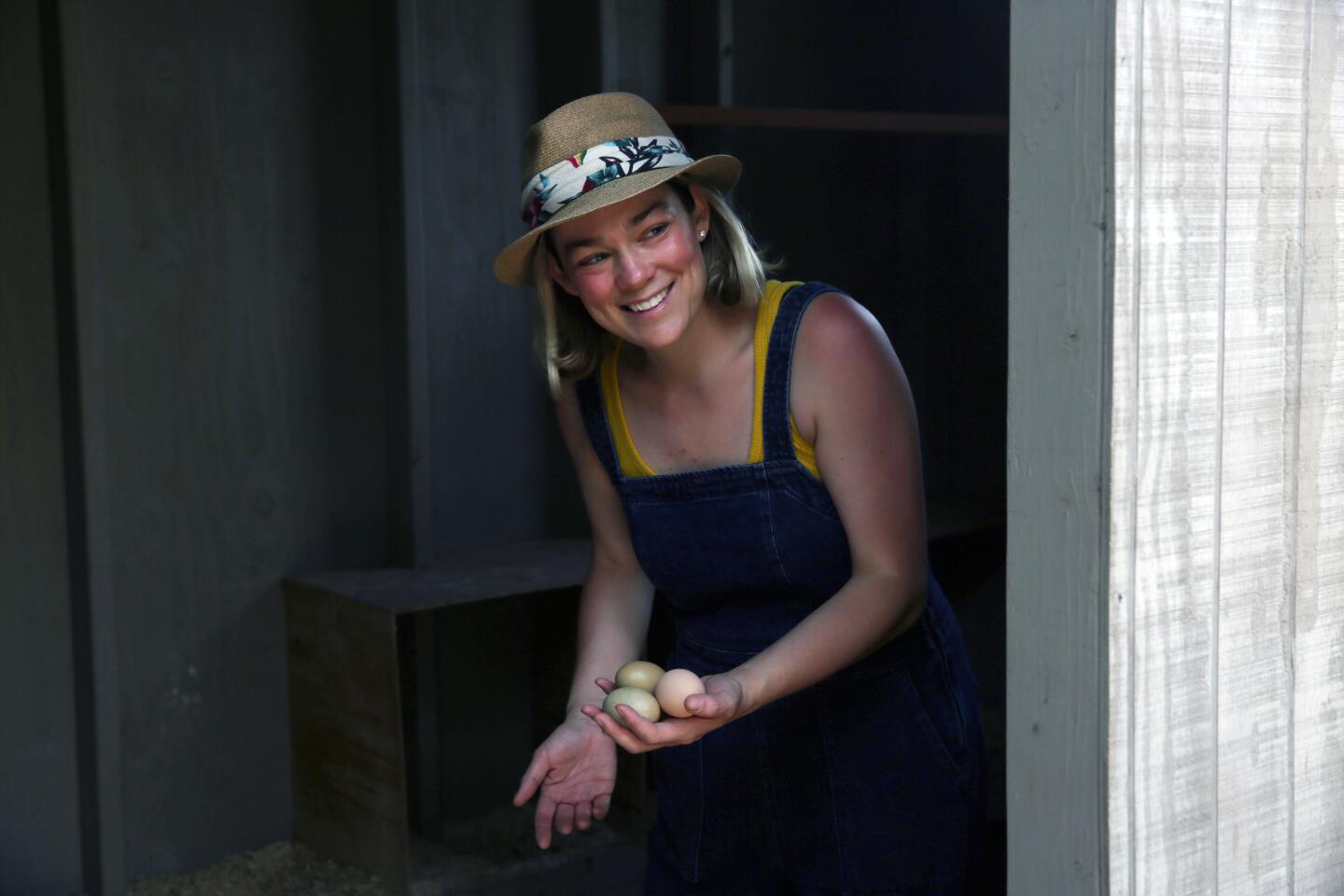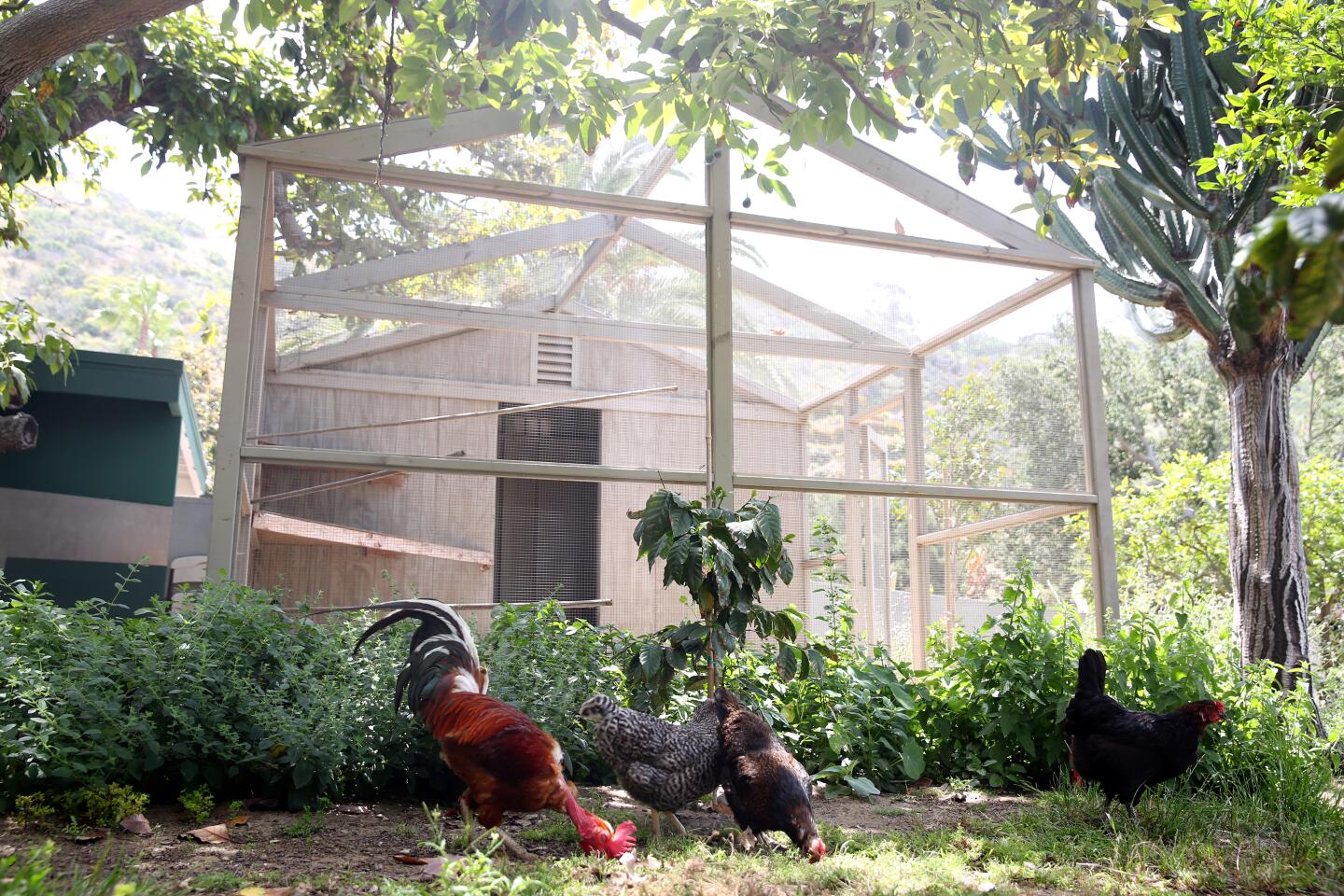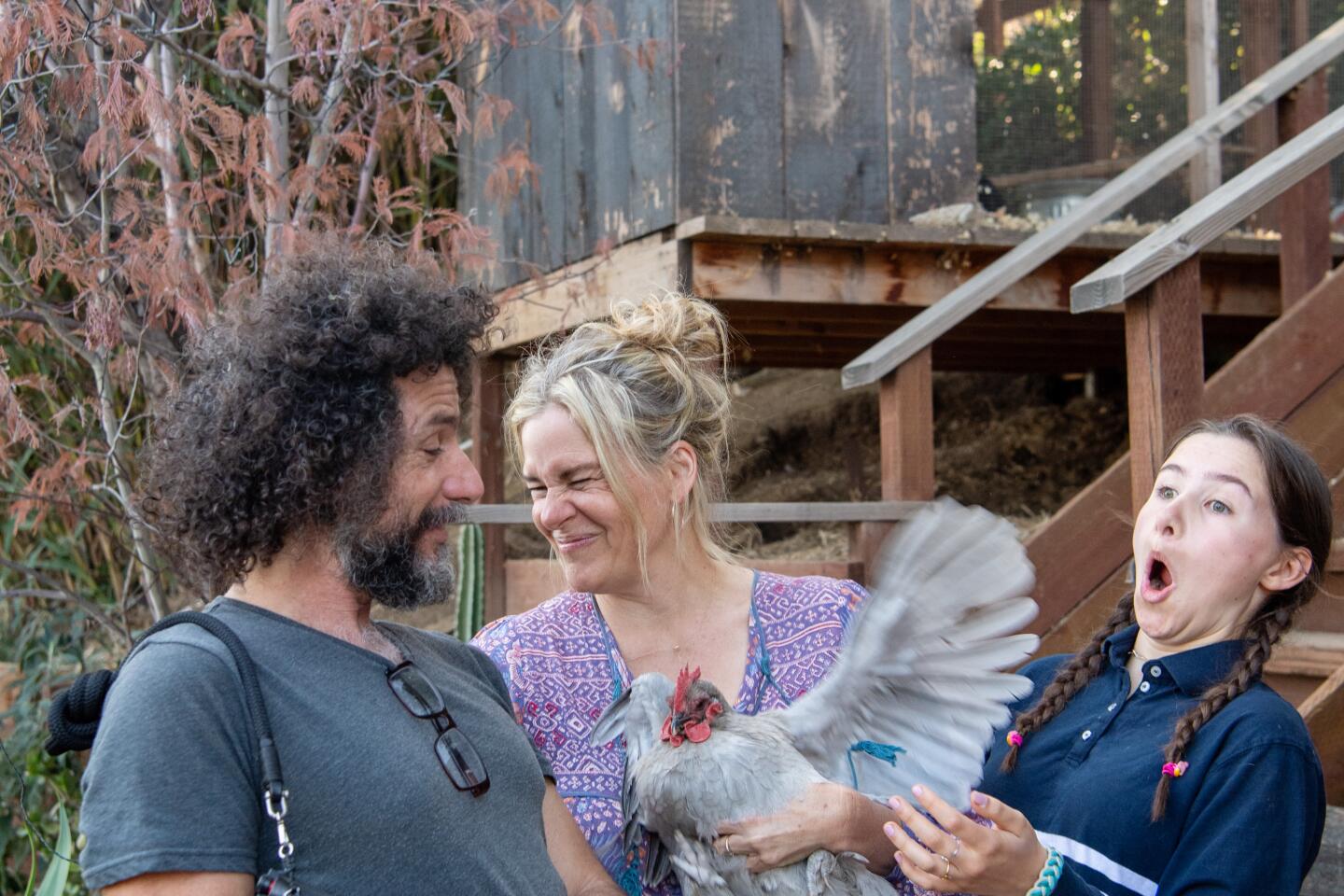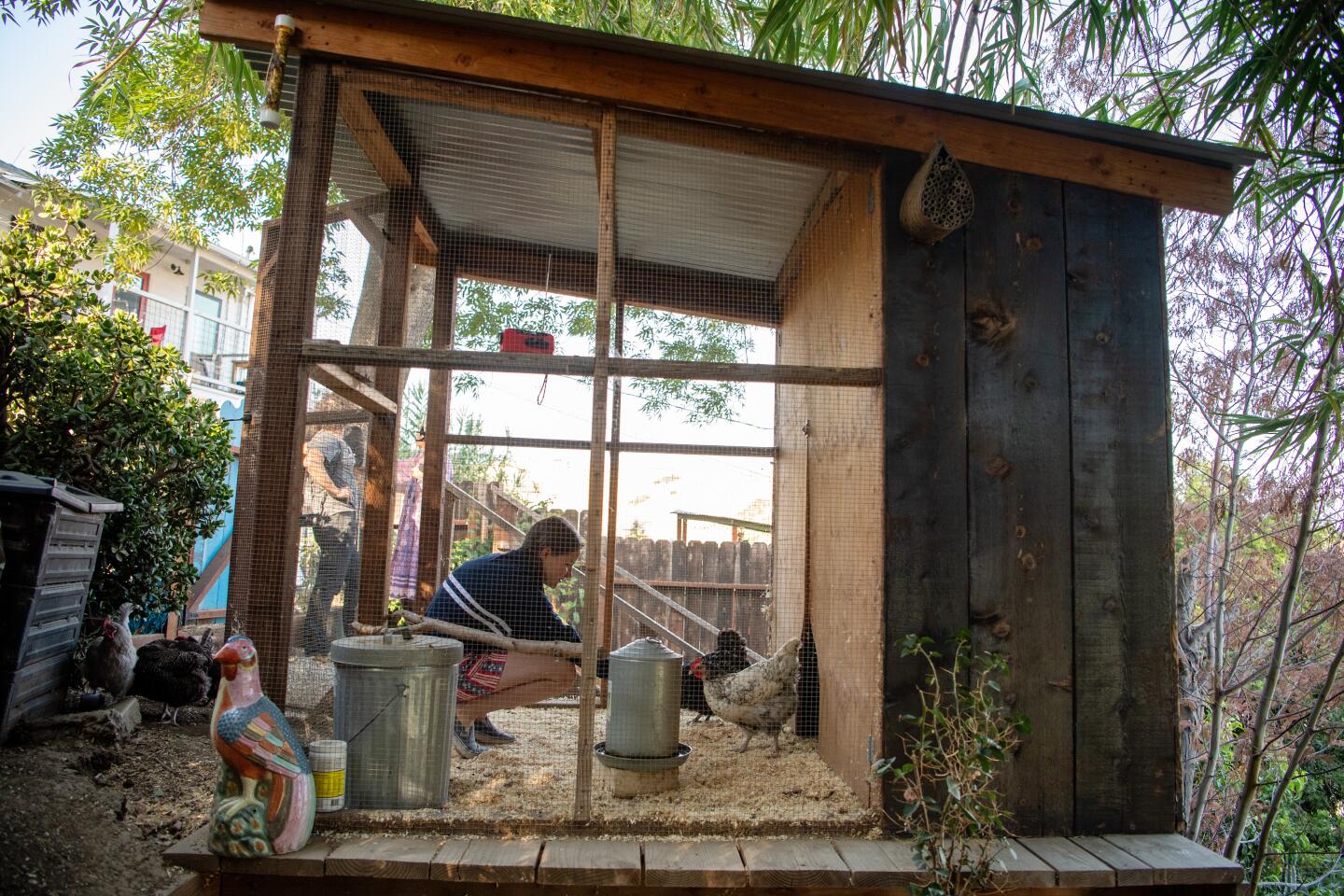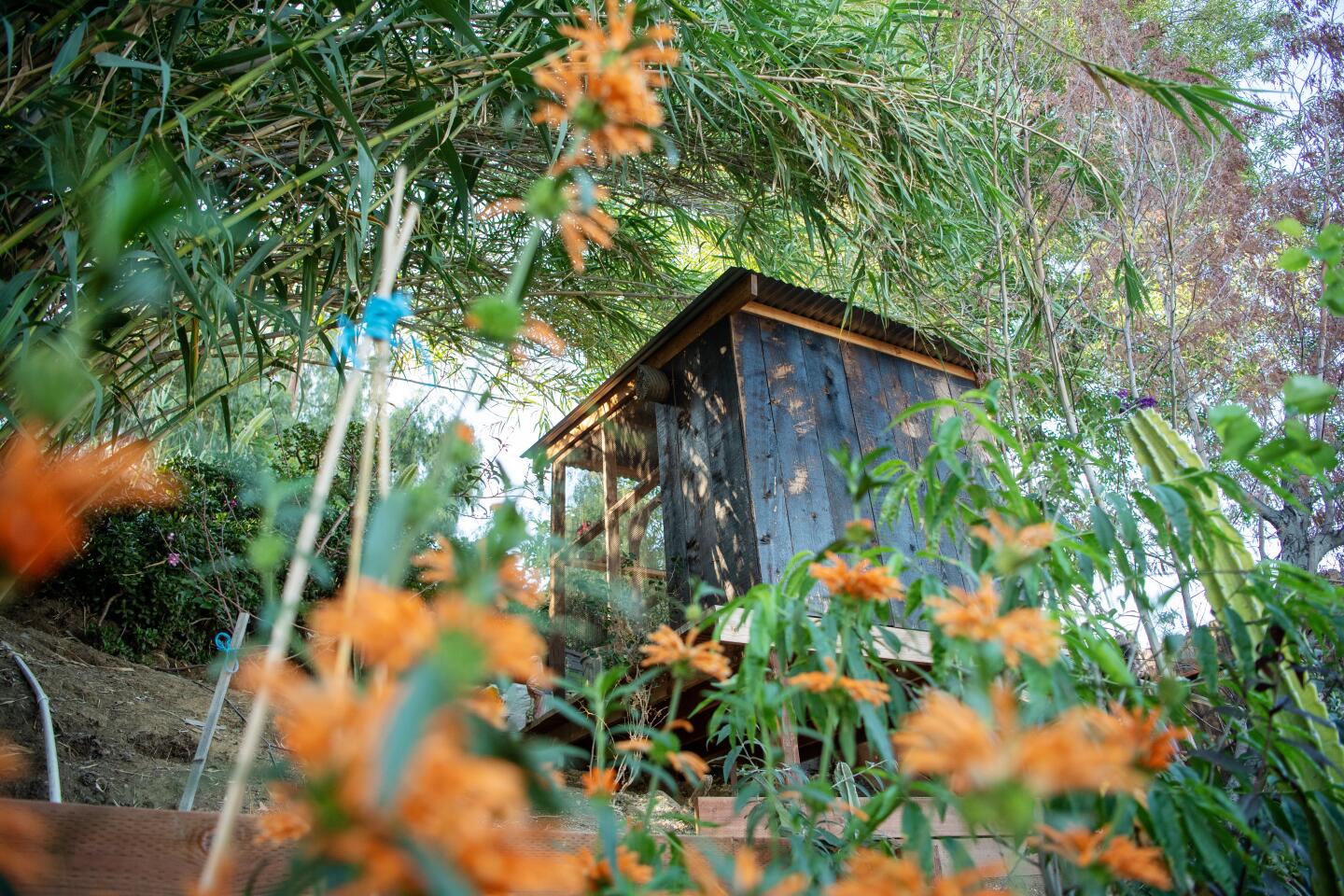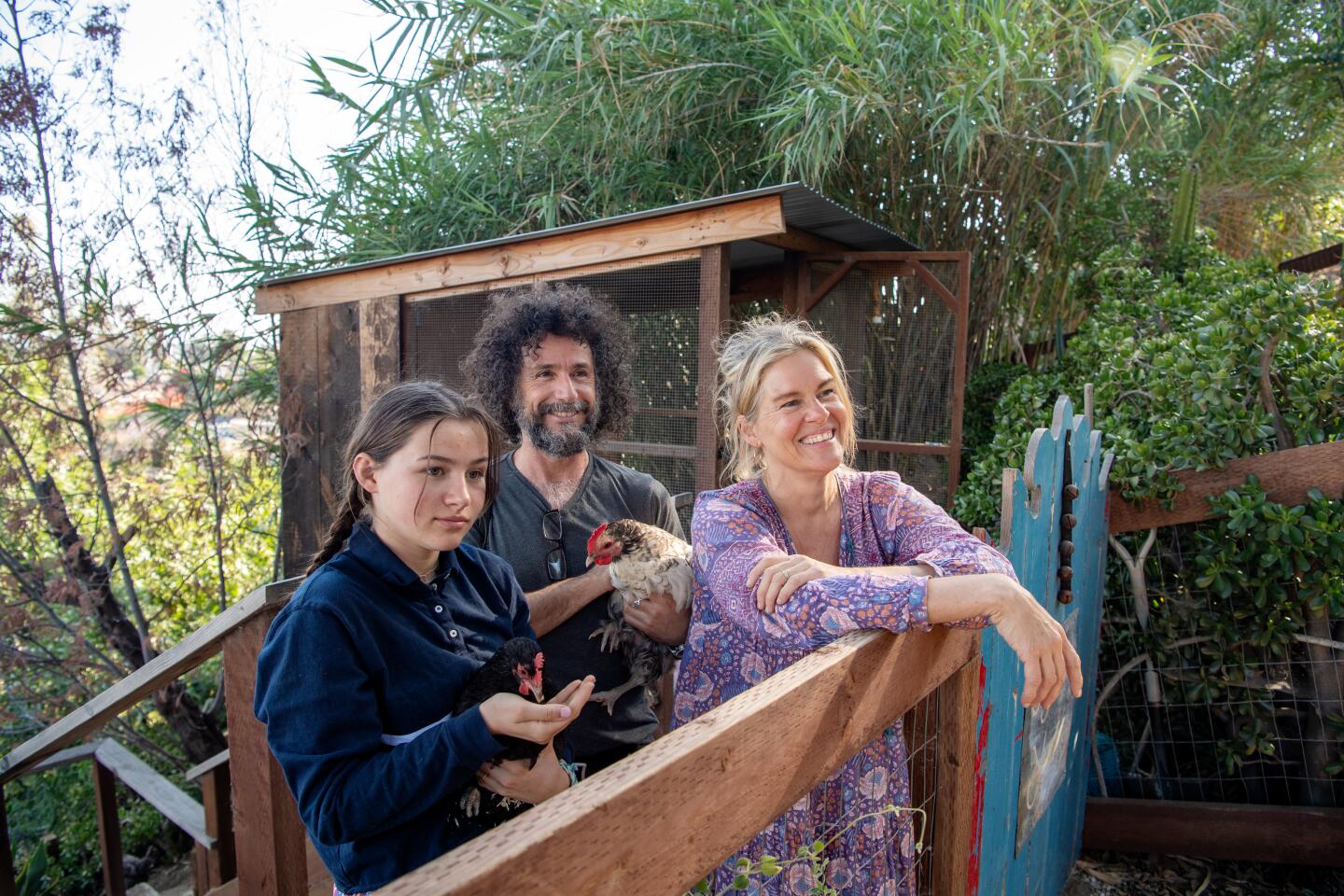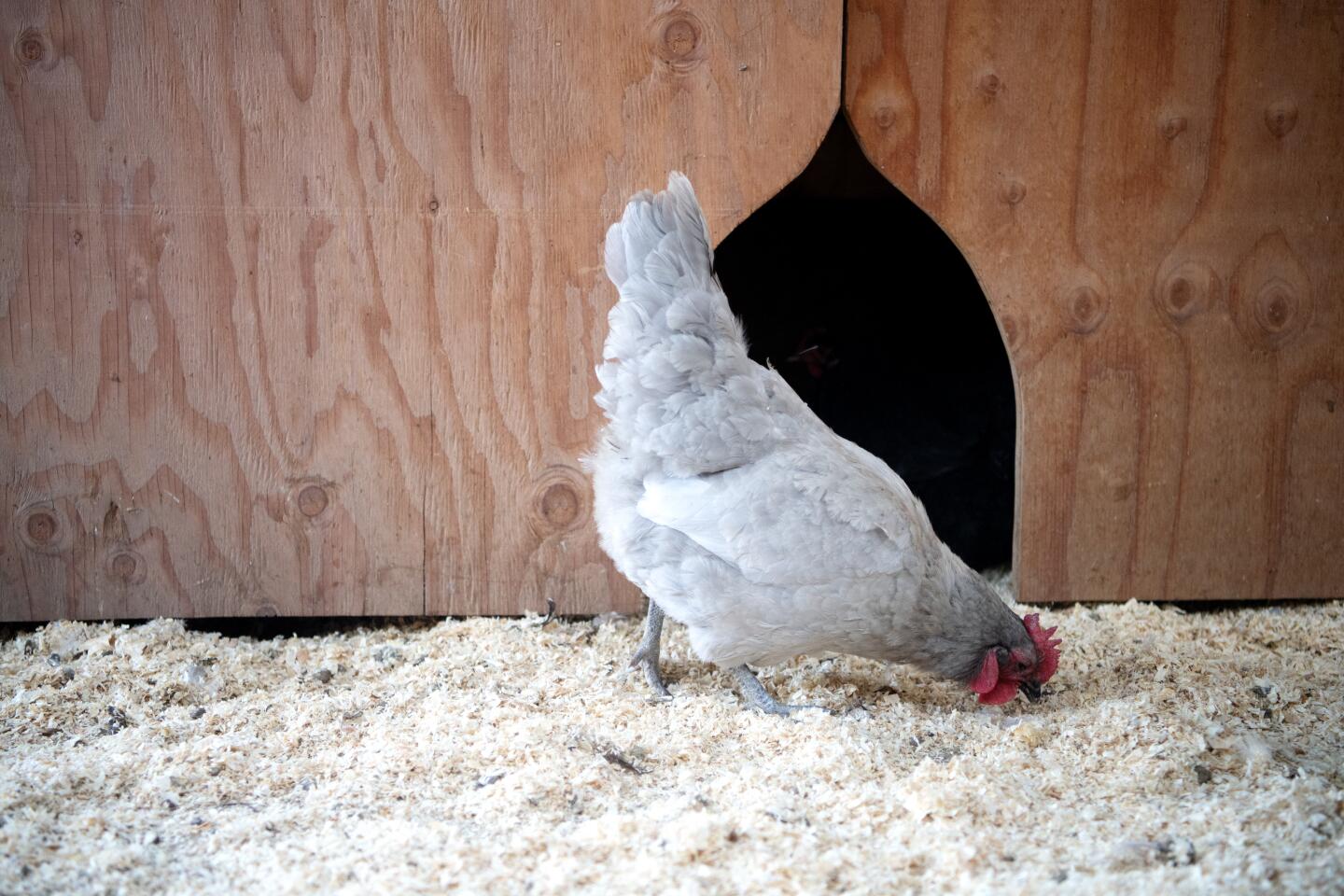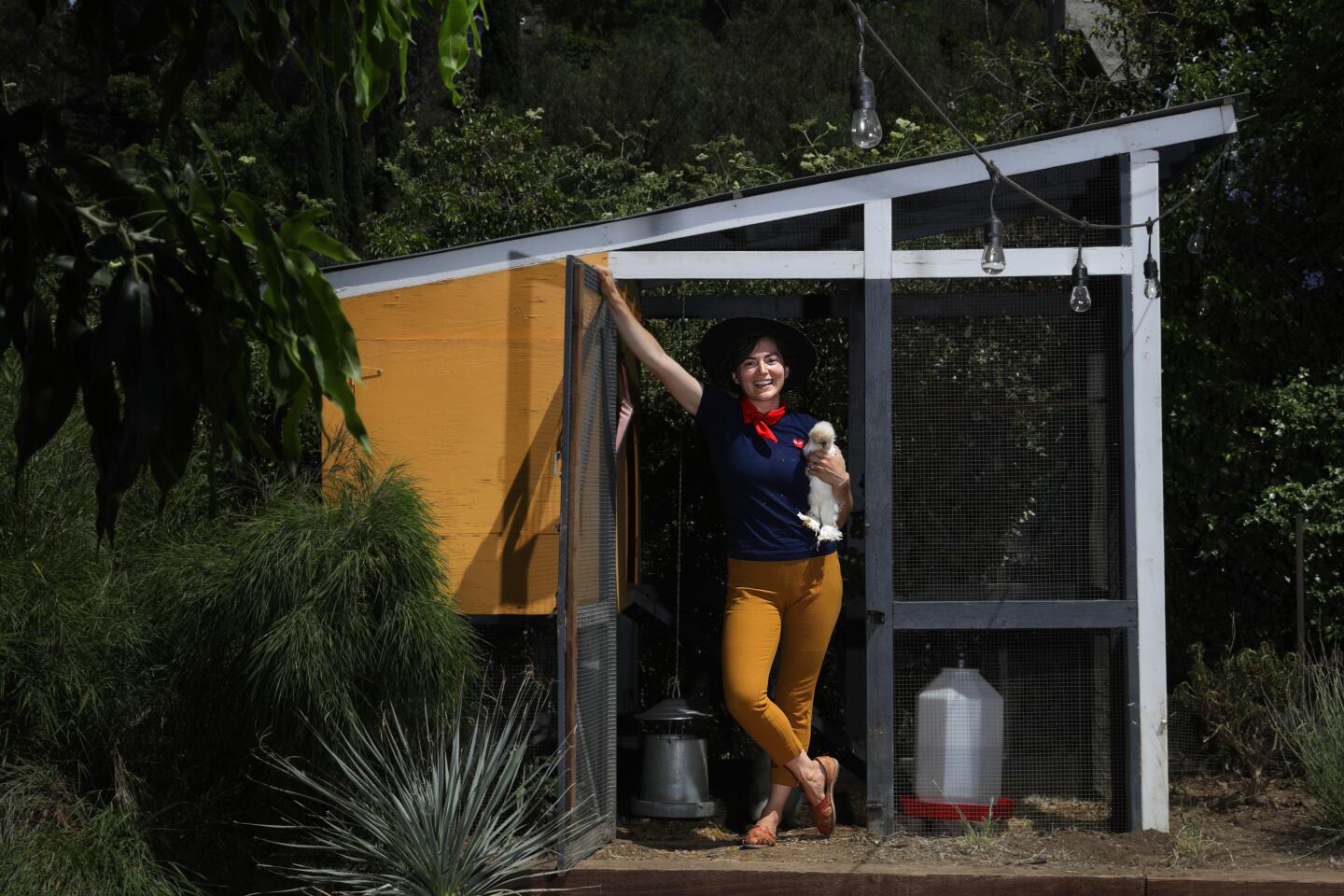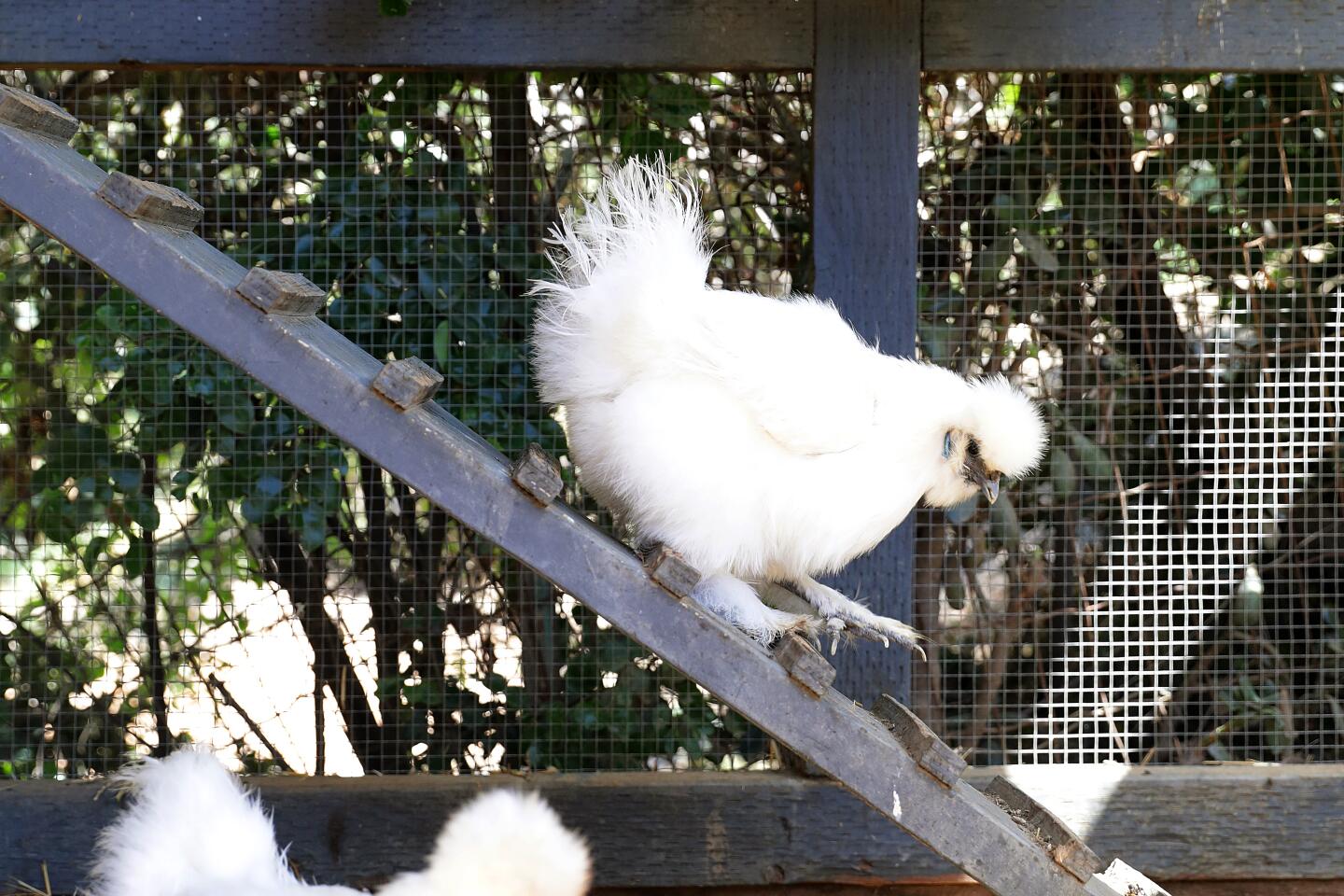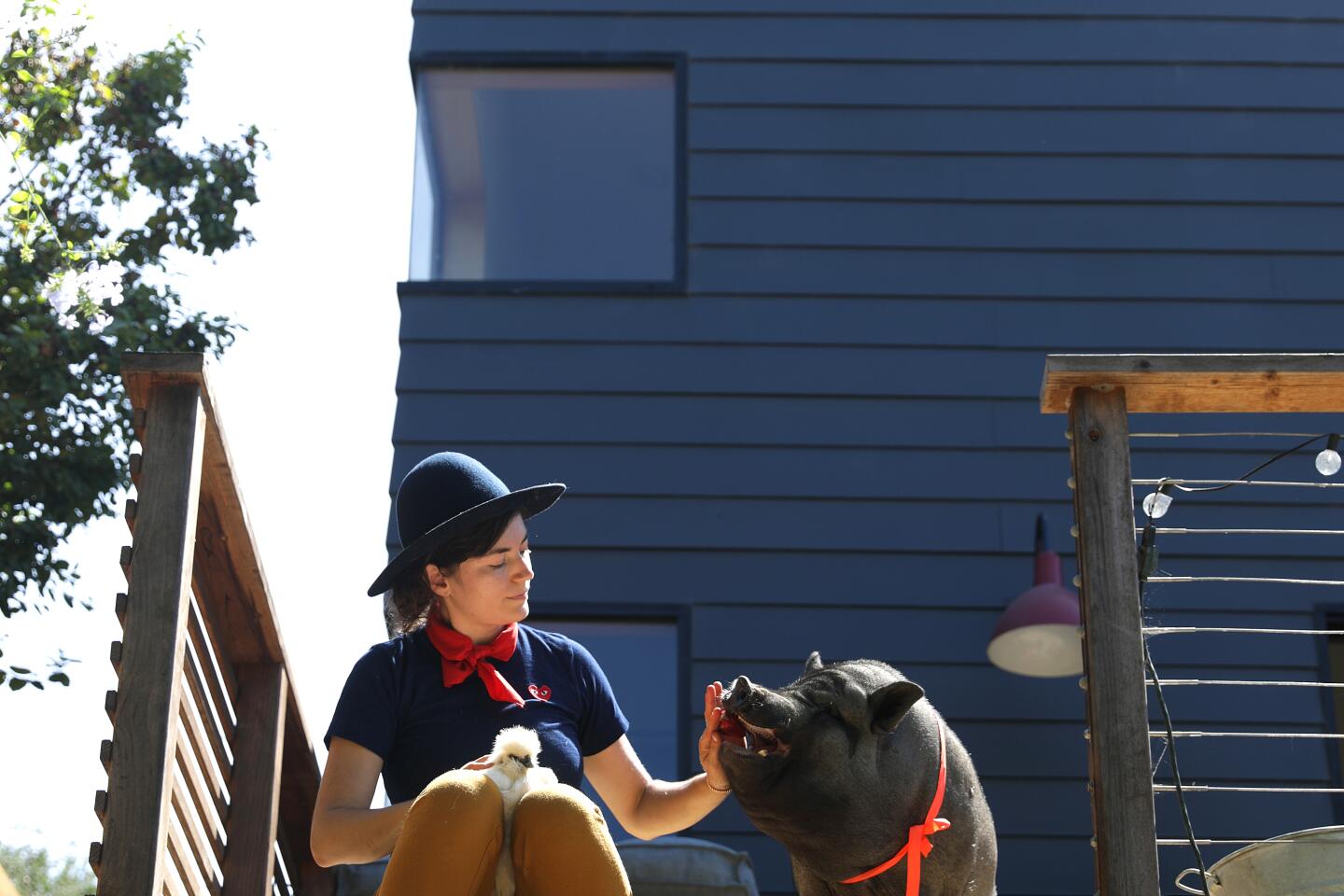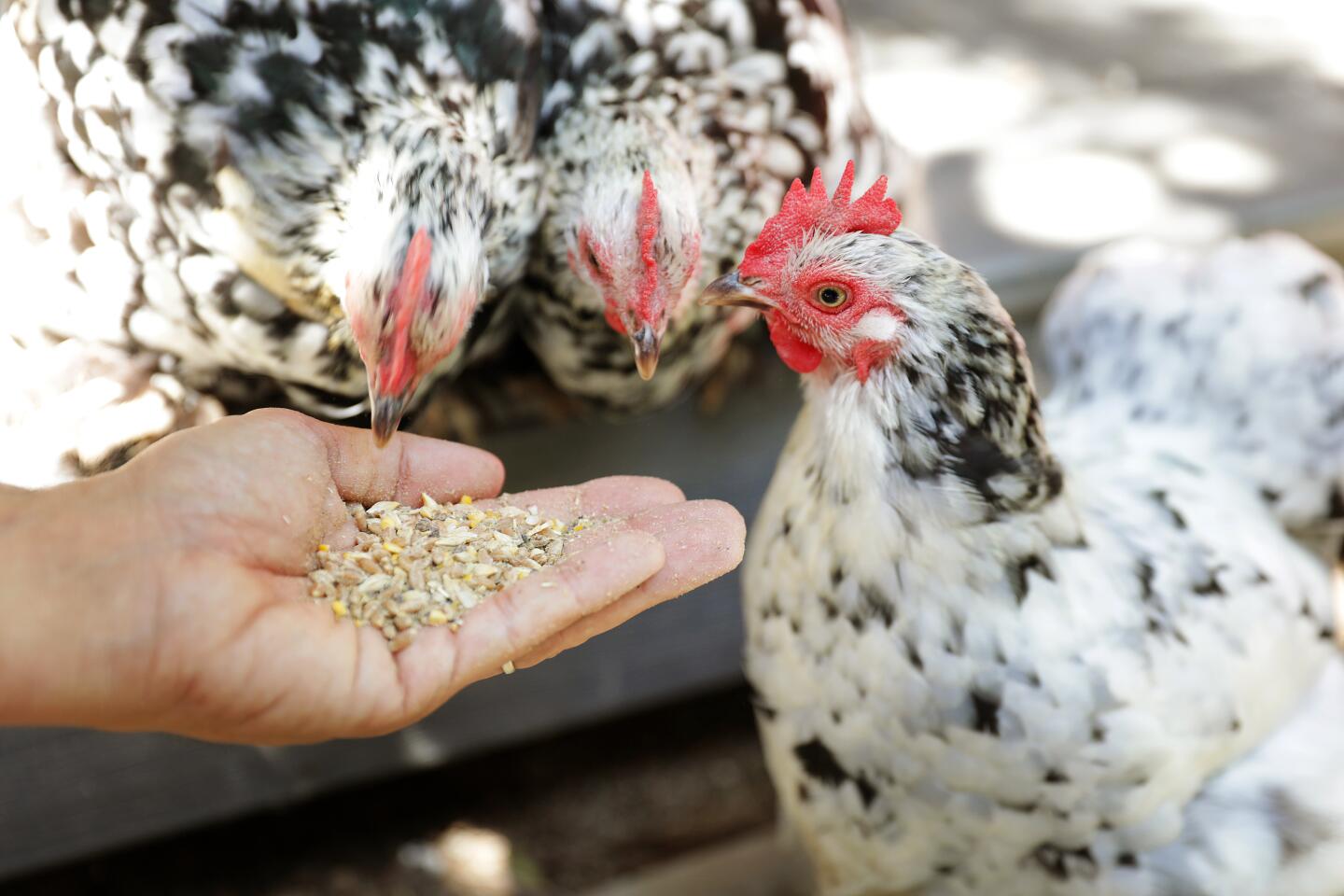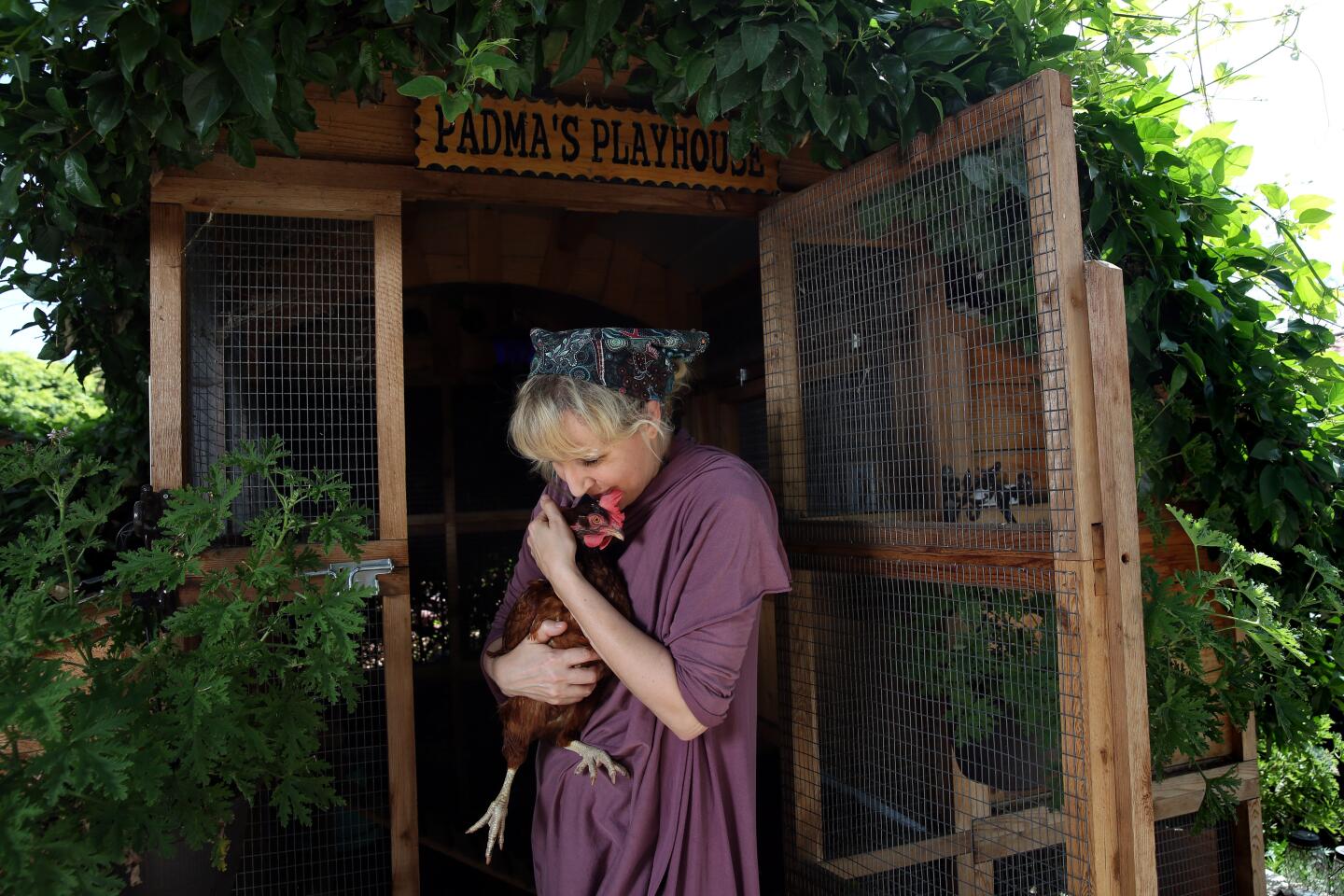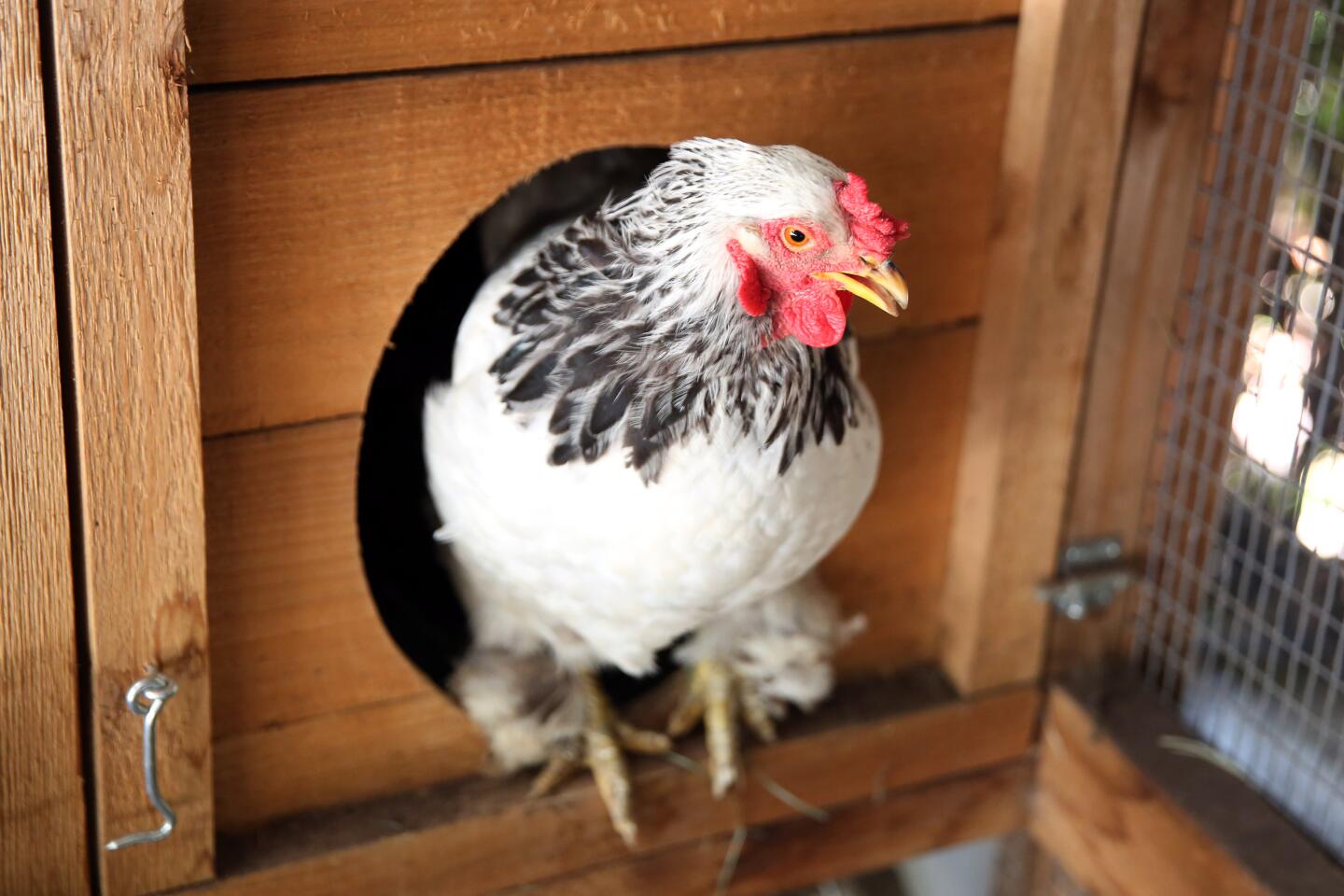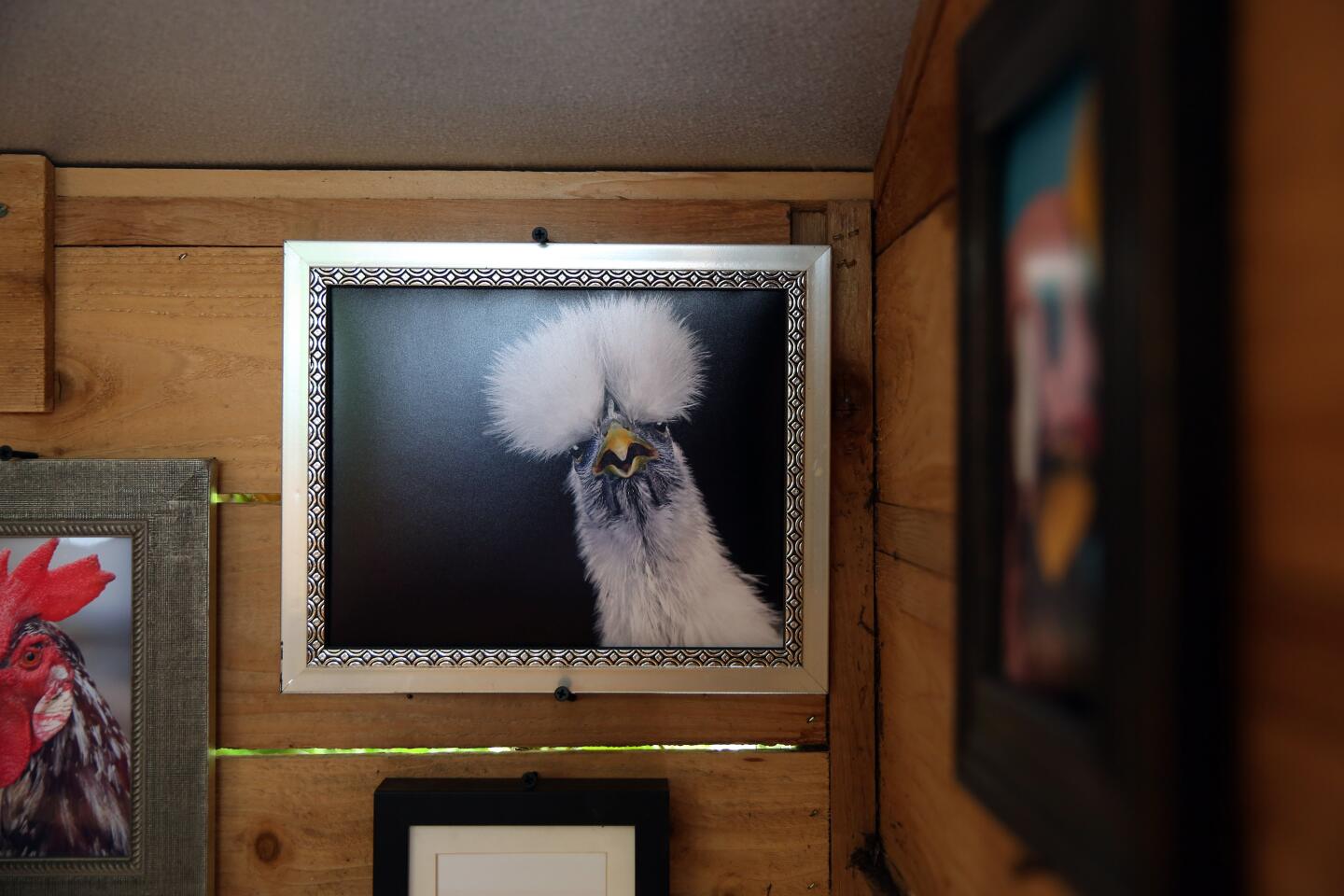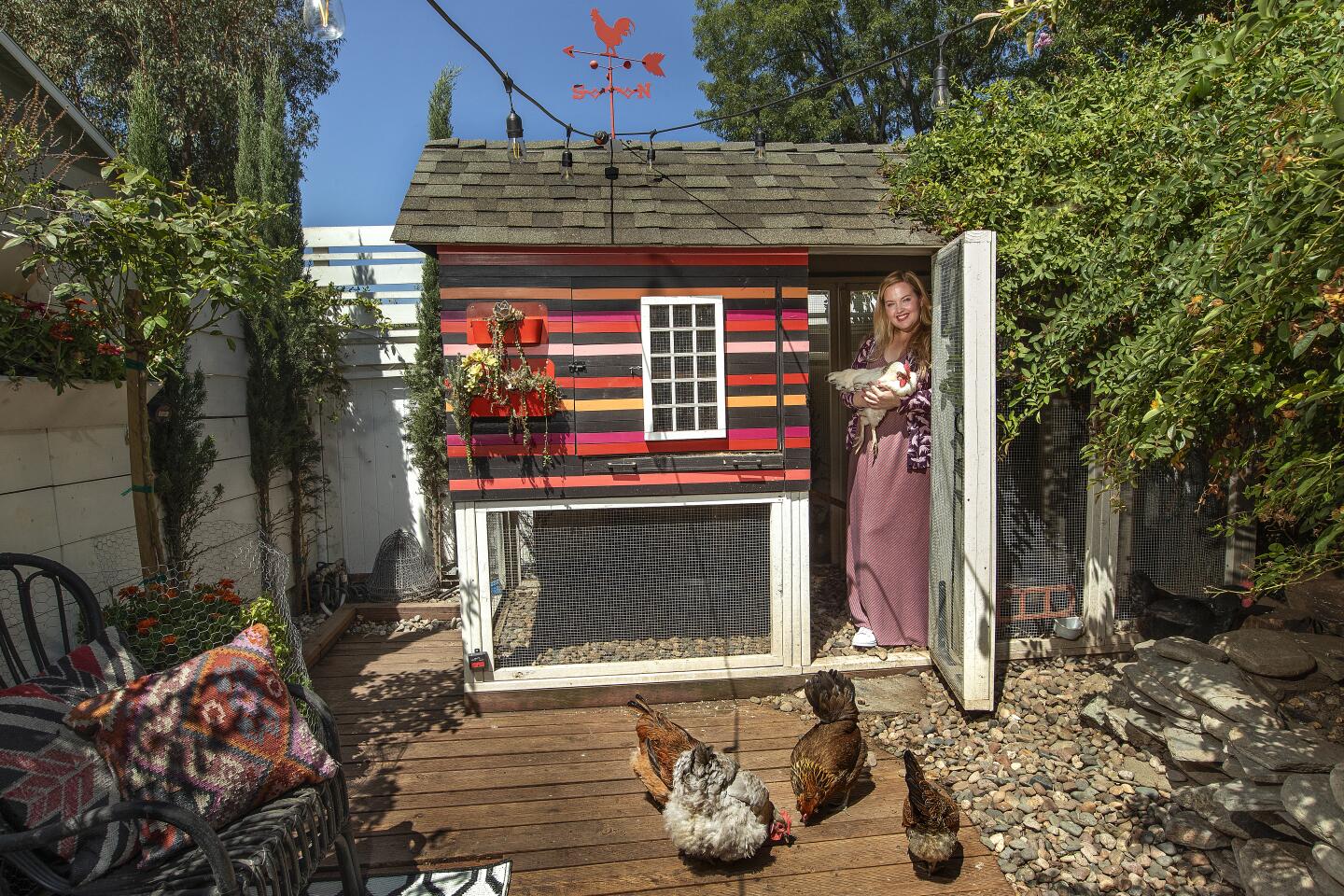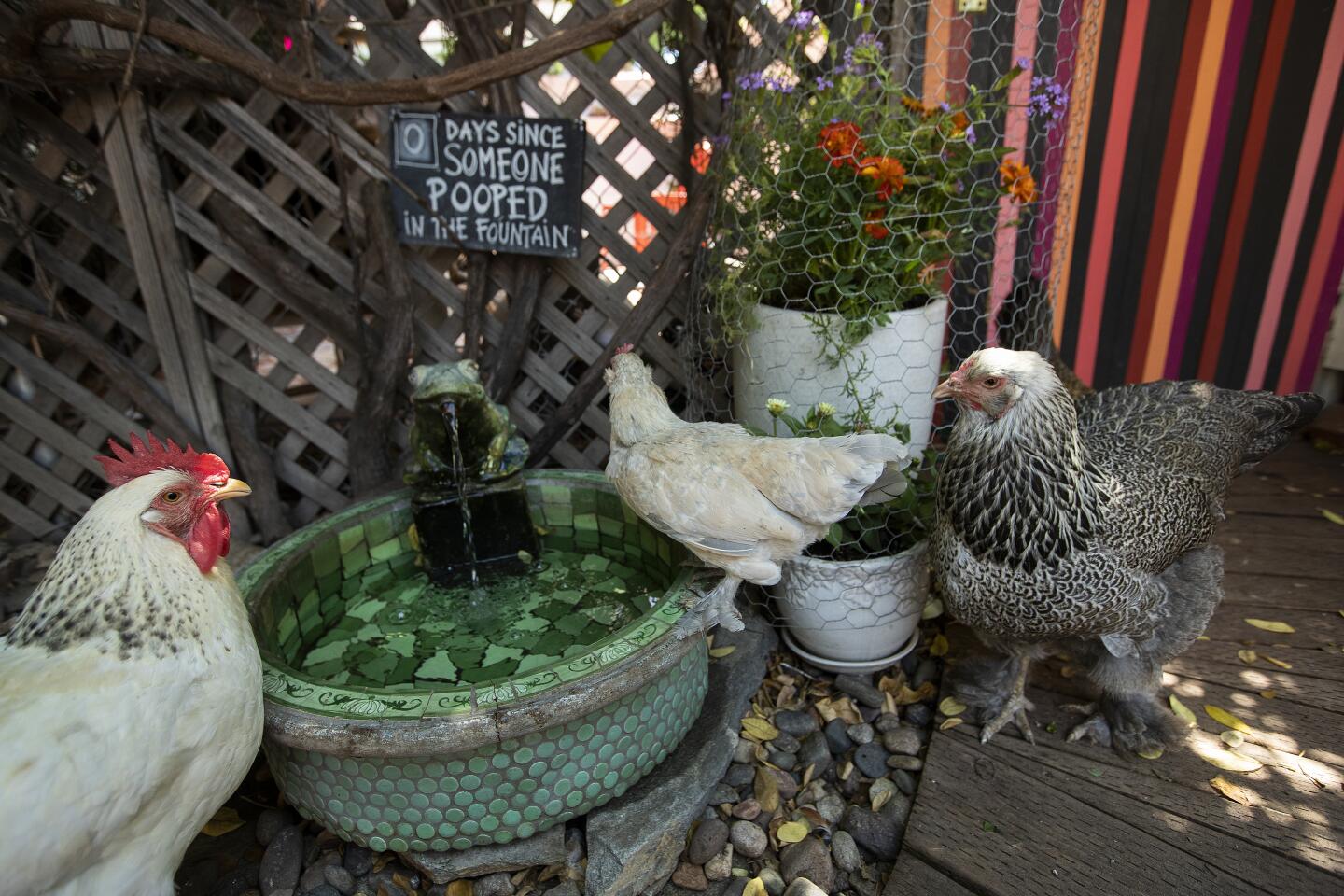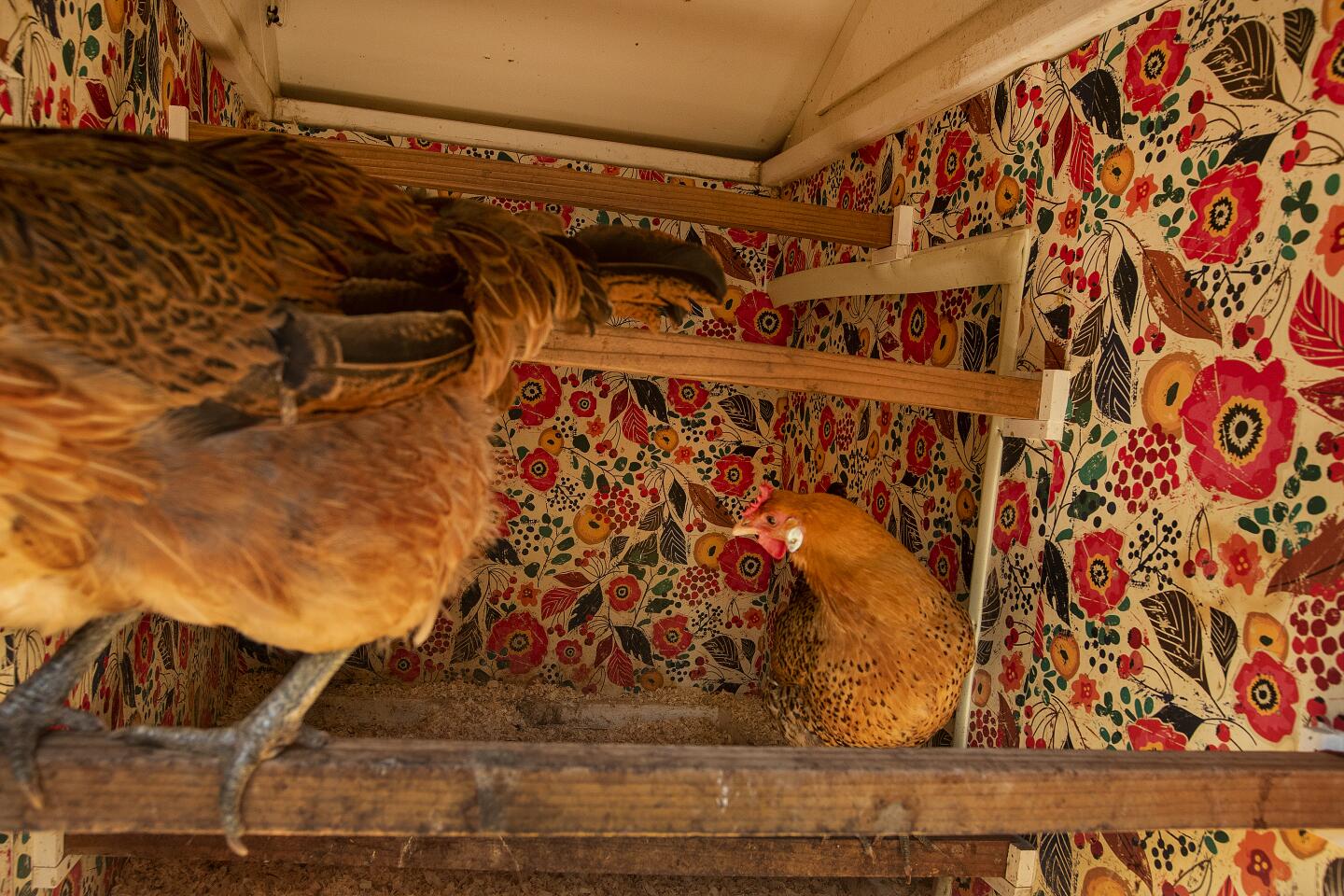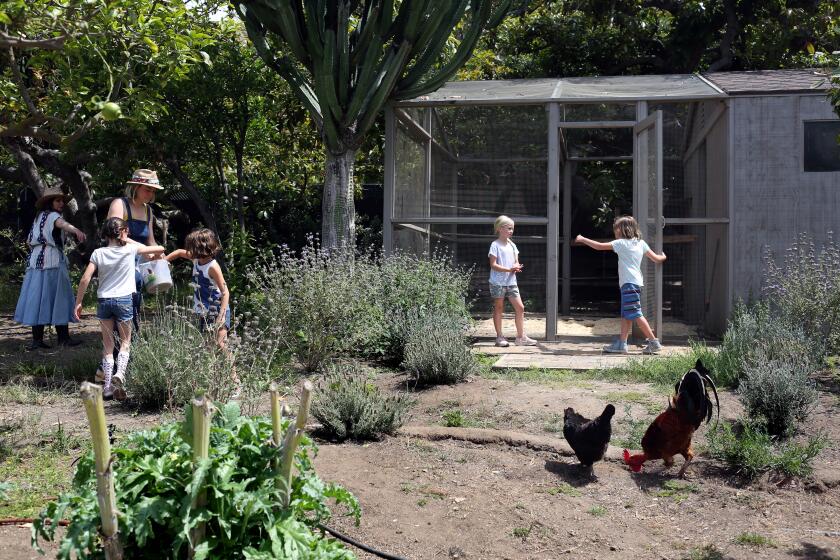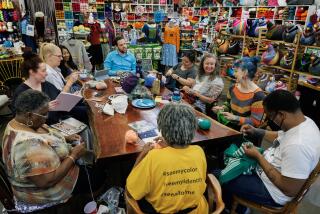Designer chicken coops: From chandeliers to AC, how some L.A. owners pamper their pets
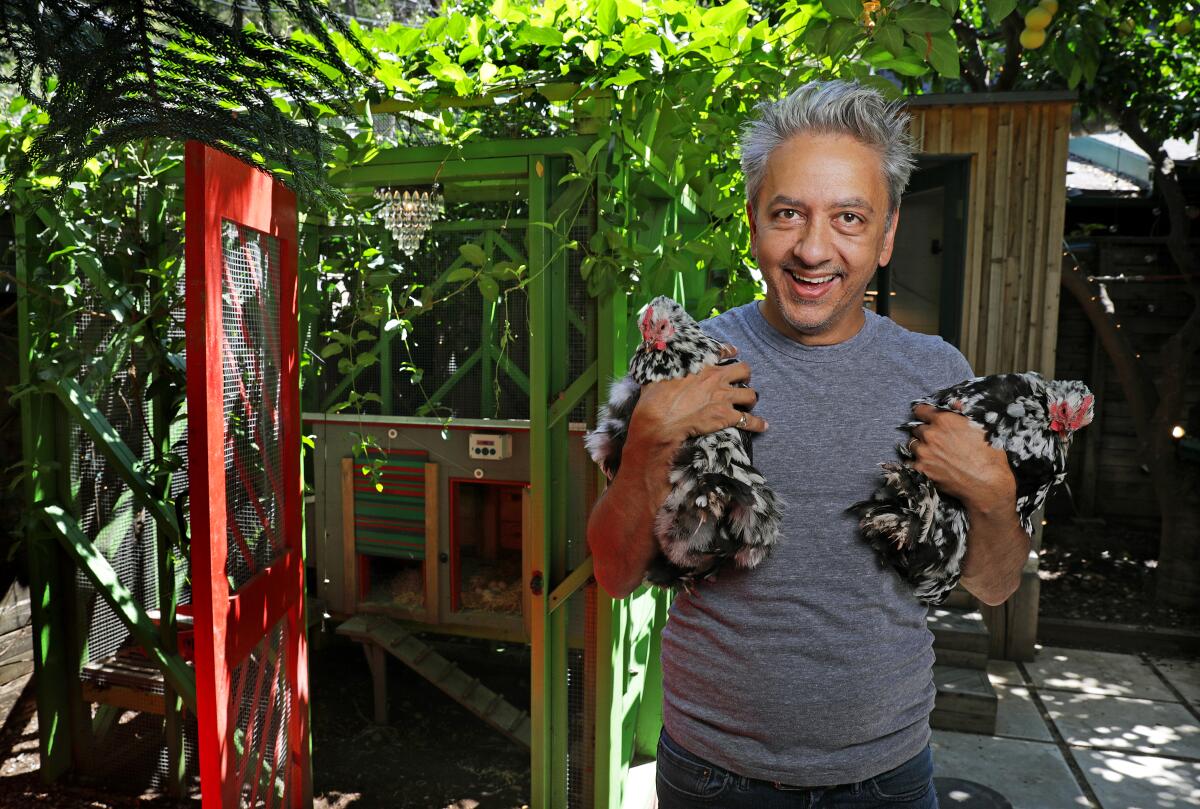
Midcentury Modern architecture and Japanese shou sugi ban wood exteriors. Wall-to-wall block-print wallpaper and shabby chic crystal chandeliers. These are not features on a Los Angeles home tour but the kind of amenities you might find in some of the city’s more elaborate chicken coops.
In a city obsessed with design and indoor-outdoor living, it makes sense that some chicken owners want to house their pets in high-style comfort. In addition to giving homeowners the opportunity to personalize their living spaces, urban homesteading offers a taste of pastoral life that is elusive in a city of more than 4 million.
As backyard chickens continue to make the news in California after recent cases of Newcastle disease, it is worth noting that chicken-tending can be traumatic. Free-ranging can be deadly. Coyotes, raccoons, hawks — even mountain lions — will prey on hens. Extreme heat can overwhelm chickens because they don’t sweat. And something as simple as a backyard avocado can prove fatal to chickens.
So why do urban homesteaders endure heartache, illness and loss? Because chickens are like any other pet: They make people happy.
“It is extraordinary to have chickens and fresh eggs and engage with them,” says gardening consultant Lauri Kranz, author of the recent book “A Garden Can Be Anywhere: Creating Bountiful and Beautiful Edible Gardens.” “I love visiting my clients who have chickens. They are always so happy to see me. But I always have a serious talk with clients who want them. When you raise chickens, you are engaging with the natural world in a whole different way. No matter how well your chicken coop is built, it still runs the risk of predators. They are more than cute and sweet and fun. It’s a huge responsibility.”
What follows are tales of six urban homesteaders and how they personalized their chicken coops, in budgets that ranged from $750 to $14,000.
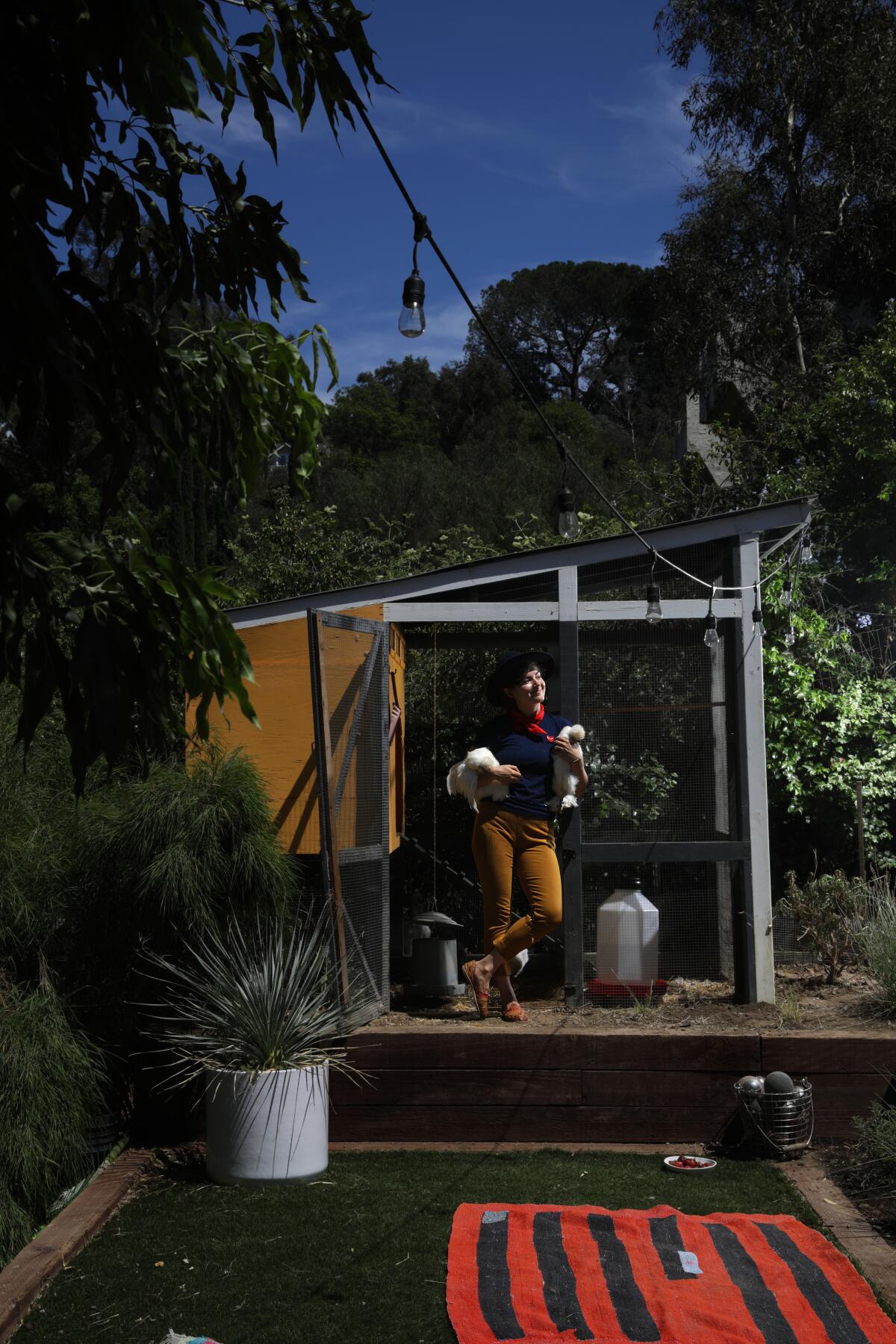
MIDCENTURY MODERN
Echo Park
Inspired by the clean lines of Midcentury Modern architecture, Casey Caplowe and Ellen Marie Bennett wanted a chicken coop that would complement the lines of their home. “We wanted an Eames-inspired chicken coop,” says Bennett, founder of the culinary goods brand Hedley & Bennett. In a nod to the ’50s, Caplowe, cofounder of Good magazine, built a slant-roof coop and painted it a vibrant yellow. The color palette augments the home’s animated interiors, highlighted by a yellow Bertazzoni range, aquamarine Heath tile and an orange sliding barn door. Located at the bottom of a terraced yard filled with drought-tolerant plants, edibles and decomposed granite pathways, the Midcentury-style hen house is home to a group of Silkies that Bennett refers to as “the ladies.” Olive Oil is the only survivor of a flock that died during a heat wave last year. She now chooses to live in a backyard tree, visiting the coop for meals when not socializing with Oliver, the family’s 200-pound pig, on the upper deck. “Olive Oil has laid eggs in his pig hut,” says Bennett, a former chef. “I like the idea that when people come over, they can go outside and enjoy the ladies. It’s fun to show people where their food comes from.”
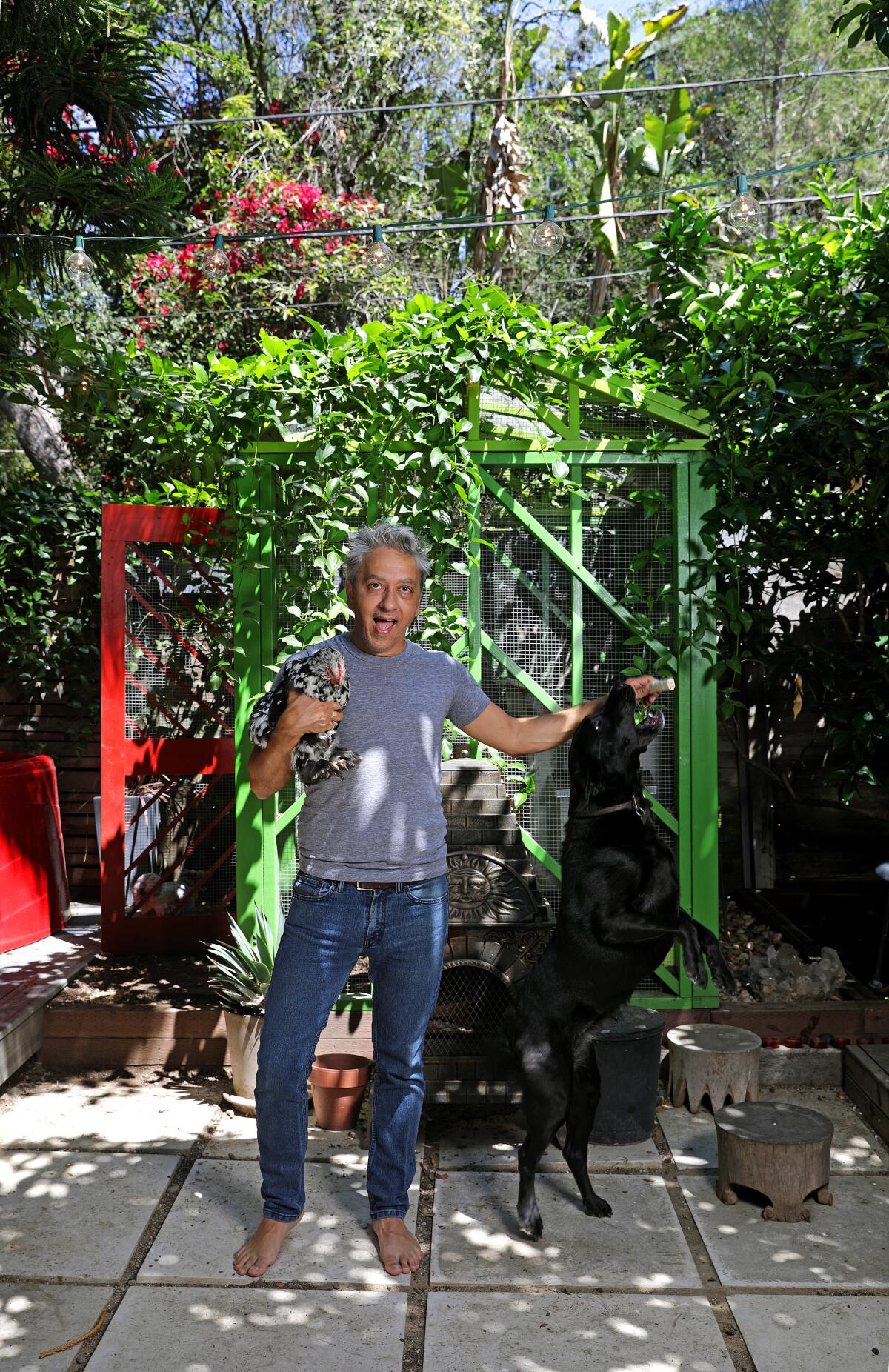
URBAN MODERN
Beverly Crest
As a principal and design director at Gensler, the world’s largest architectural firm, Irwin Miller has overseen everything from Eataly in Century City to Shonda Rhimes’ new office across from Paramount Studios in Hollywood. So it is not surprising that Miller’s chicken coop is a distinctive structure on a property steeped in Hollywood lore (“Apocalypse Now” screenwriter John Milius lived here). The lush compound is home to several small structures: a 900-square-foot main house, a 400-square-foot studio, a detached “man cave” for Miller’s two sons and a “she shed” for wife Heidi. Miller built the coop over a weekend in an enclosed patio underneath an enormous grapefruit tree. The emerald green coop has a mathematical sensibility, incorporating a triangle theme that continues throughout the compound’s dwellings. At night, the family can sit outside and enjoy the four silver-laced Cochins, their sweet lab, Olive, and a nearby hot tub. A surplus of vines helps keep the coop cool, and a motorized door (opener around $200 from ChickenGuard) that Miller detailed with red and green stripes opens and closes automatically when the family is not around. Miller hung a sparkling, shabby chic-style chandelier from the center of the coop. “The crystal is a nice touch,” he says with a wink. “It exudes good energy.”
These luxury chicken coops will have you crowing
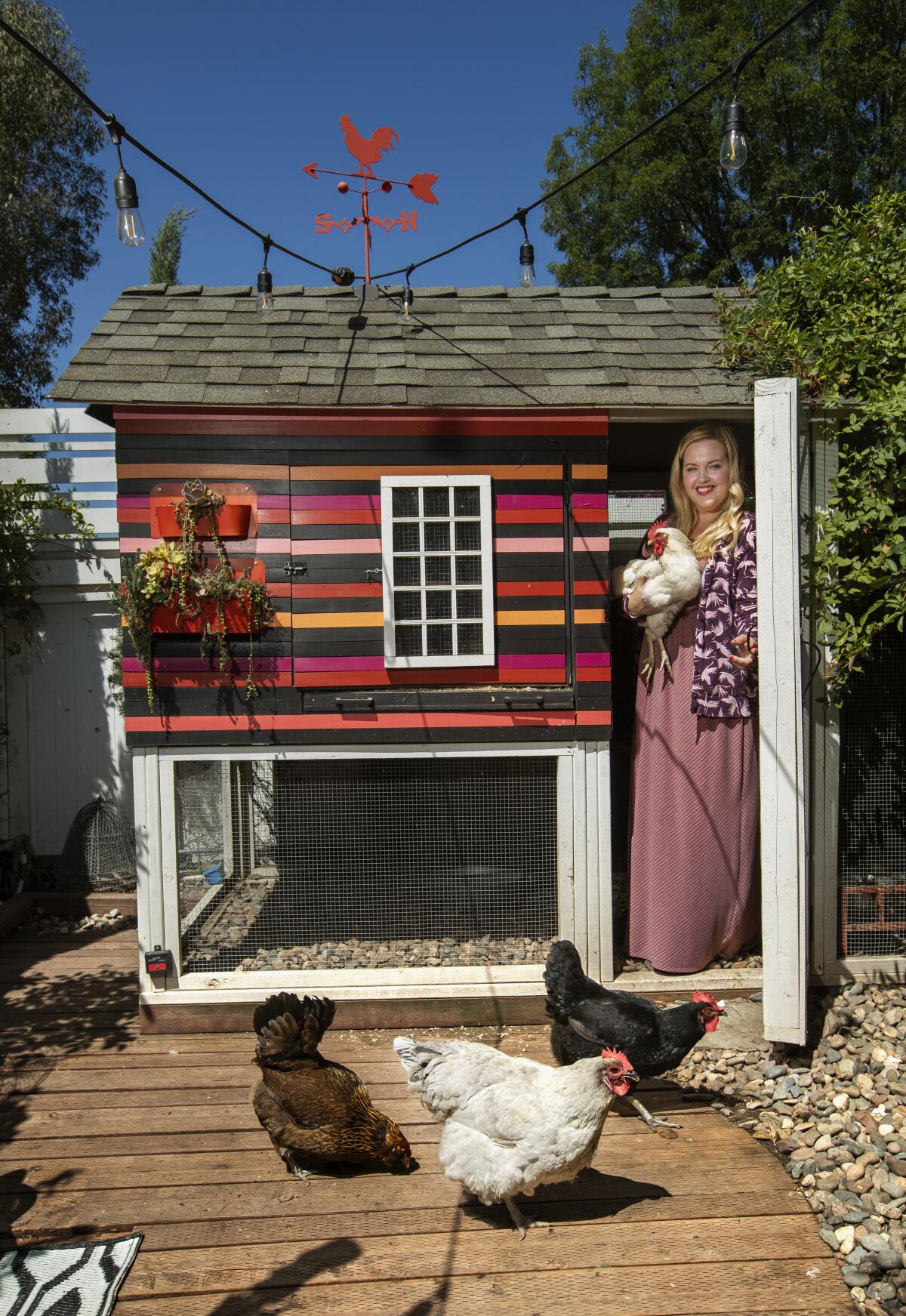
FARMHOUSE
San Gabriel Valley
For Kate Richards, whose hilarious website Drinking With Chickens encourages readers to interact with their chickens while enjoying a “garden-to-glass” cocktail, living well means ending the day outdoors with her husband, Jonathon Ragsdale, their flock of 10 chickens and a lavender-infused tequila sunrise. In eight years of keeping chickens, Richards has designed and built seven coops. Her latest, a fully insulated enclosure she built with Ragsdale and father Rich Richards, is stylishly decorated with planters, pink and coral painted stripes, and vinyl peel-and-stick botanical block-print wallpaper by Sarah Treu for Spoonflower ($7.50 per foot). The wallpaper may seem extravagant, but Kate Richards says it “camouflages poop on the wall and is easy to wipe down.” She originally wanted the flock — which averages about 10 eggs per day — to roam free, but after they foraged everything in her yard, she installed the coop in a 15- by 25-foot enclosed garden at the back of her property. There, the chickens can exercise in a run made of pressure-treated wood, while vines and shrubs protect them from hawks and owls. The run rests on 12-inch-deep permeable pebbles so Richards can sweep and hose the path when necessary. A comfortable seating area, outfitted with lounge chairs and custom iron wine glass holders, and an adjacent cocktail bar provide ample room for guests and entertaining. “It’s very tranquil out here,” says Richards, whose book “Drinking With Chickens” is due in the spring. “Chickens are funny and entertaining creatures. They are filled with joy. All I’m doing is encouraging people to take a moment to enjoy them.”
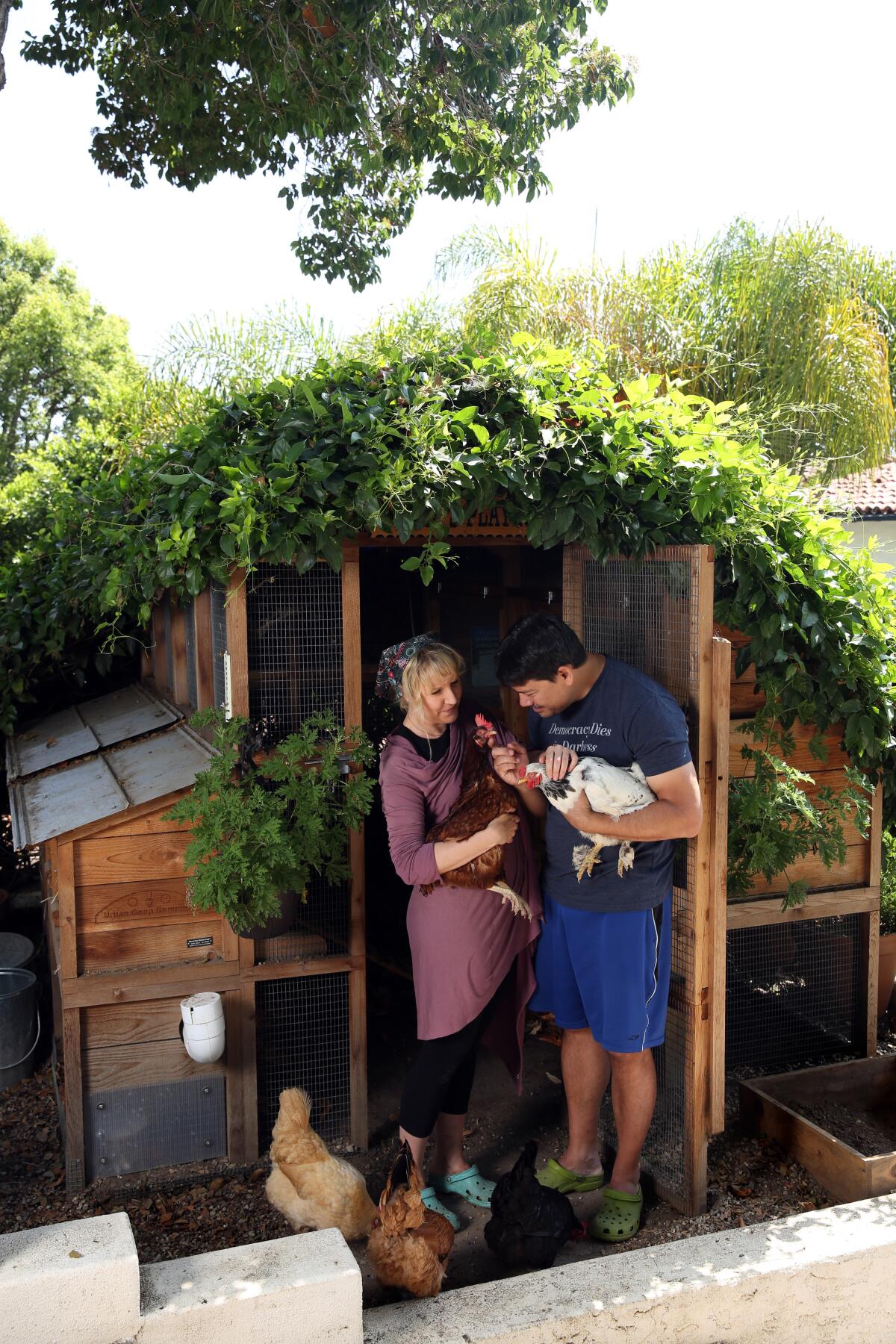
BOHEMIAN
Los Feliz
Since launching their homesteading store, the King’s Roost, five years ago in Silver Lake, Trish and Roe Sie have offered goods and classes well suited to Los Angeles’ do-it-yourself culture. So when it came time to purchase their own coop, the couple did extensive research before buying a Western red cedar roll-top walk-in structure from Urban Coop (starting at $4,700). Designed for 20 chickens, the coop arrived in 12 flats and took Roe a week to assemble. The couple personalized it by hanging framed photographs of roosters above the roost area, along with an image of one lone hen, “in case one of the flock is a lesbian or nonconforming,” Trish says jokingly. When the temperature hit 105 degrees last summer, the couple added a generator and an air-conditioning unit from Home Depot. Flowering trumpet vines, which shade the roof, also help cool the coop. (The couple judiciously prune the vines, which are poisonous). “Trish is the rooster,” Roe adds with a laugh. “She is the only person I have ever known who has had a flock of chickens name her.” Just outside the door to the coop, a wooden dust bath filled with clean ash helps ward off parasites. And when a neighbor greets the family over the fence, Trish emphasizes the need to be respectful of their community. “We make sure our neighbors are OK,” says Trish, director of “Pitch Perfect 3” and the forthcoming “The Sleepover.” “We are tidy. We share our eggs. We made sure the coop is the legal limit from the house.” Abundant seating and electrical outlets allow the family to work outdoors and be near their chickens. Their Rhode Island Red, Ruby, even watches casting tapes with Trish. “The worst thing about traveling for work is not being with them and my family,” she says. “I’ve thought about having them as companion pets.”
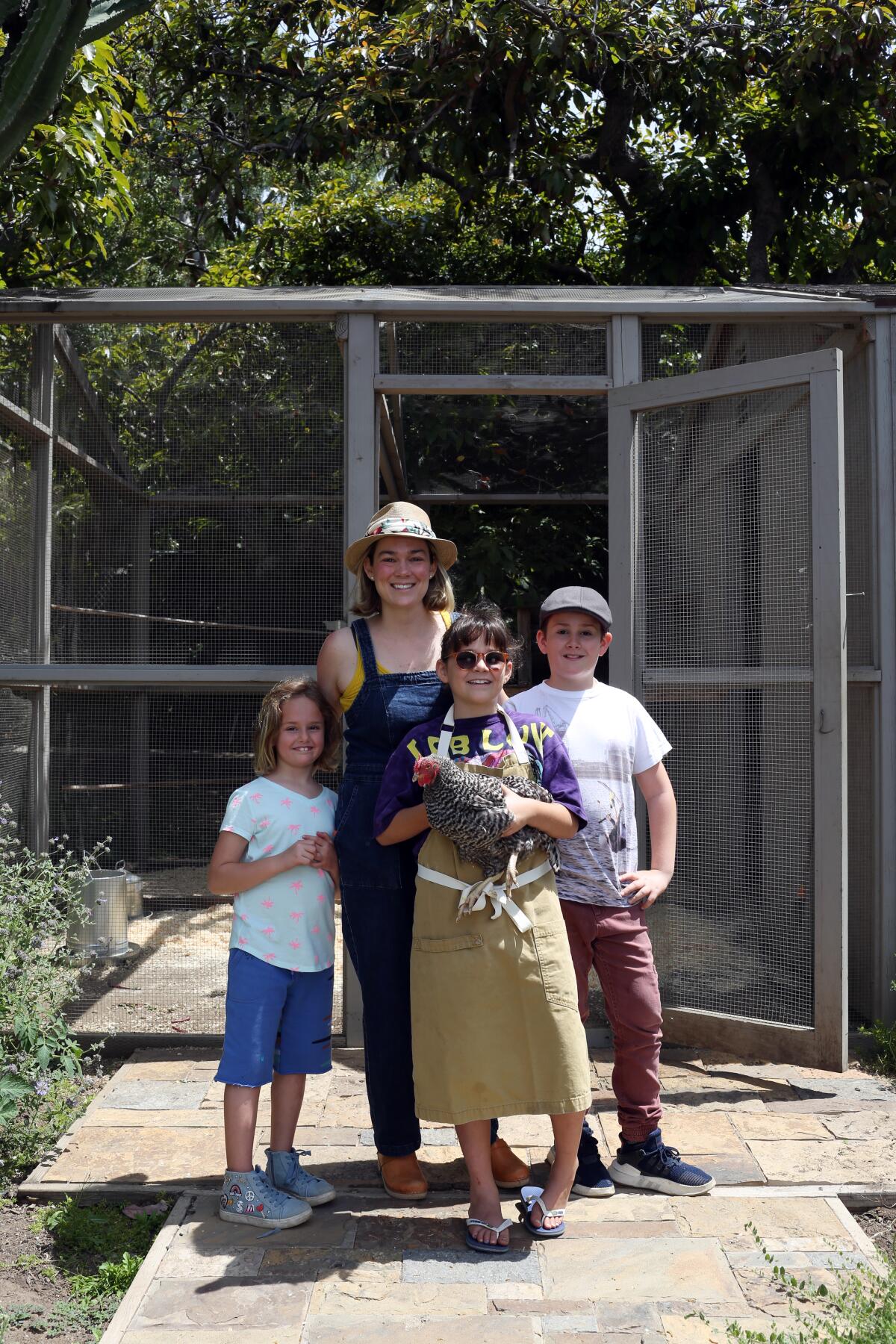
MINIMALIST
Malibu
At Plumcot Farm, Alison Hersel’s 7-acre property, everything is small batch, from the raw honey to the more than 100 types of edible and medicinal crops she has grown on the organic farm. She added chickens five years ago because she wanted to demonstrate regenerative farming to her three children in a hands-on way. The 100-square-foot wooden coop, designed and built by Edible Gardens LA, is a large, minimal structure that provides the chickens room to roam while allowing Hersel the opportunity to share and exchange information with the public. “Recently in a cooking class, one of the kids cracked a fertilized egg,” Hersel says. “Chickens prompt you to have experiences and conversations about the cycles of life.” The structure is lined with one-quarter-inch-square chicken wire that goes down 3 feet deep and surrounds the perimeter. The coop features an interior space for egg boxes and an exterior space where the chickens can meander in a protected environment (Hersel allows them to free-range outside the coop under supervision). Even with the issues that come up — a hen recently ate a baby chick — she says it is worthwhile. “Animals are a big part of regenerative farming,” Hersel says. “We don’t have the space for livestock or other animals, so we settled with chicken manure to activate our compost pile.” Adds Edible Gardens L.A.’s Lauri Kranz: “Chickens are a natural addition to the vegetable garden. It all feeds each other.”
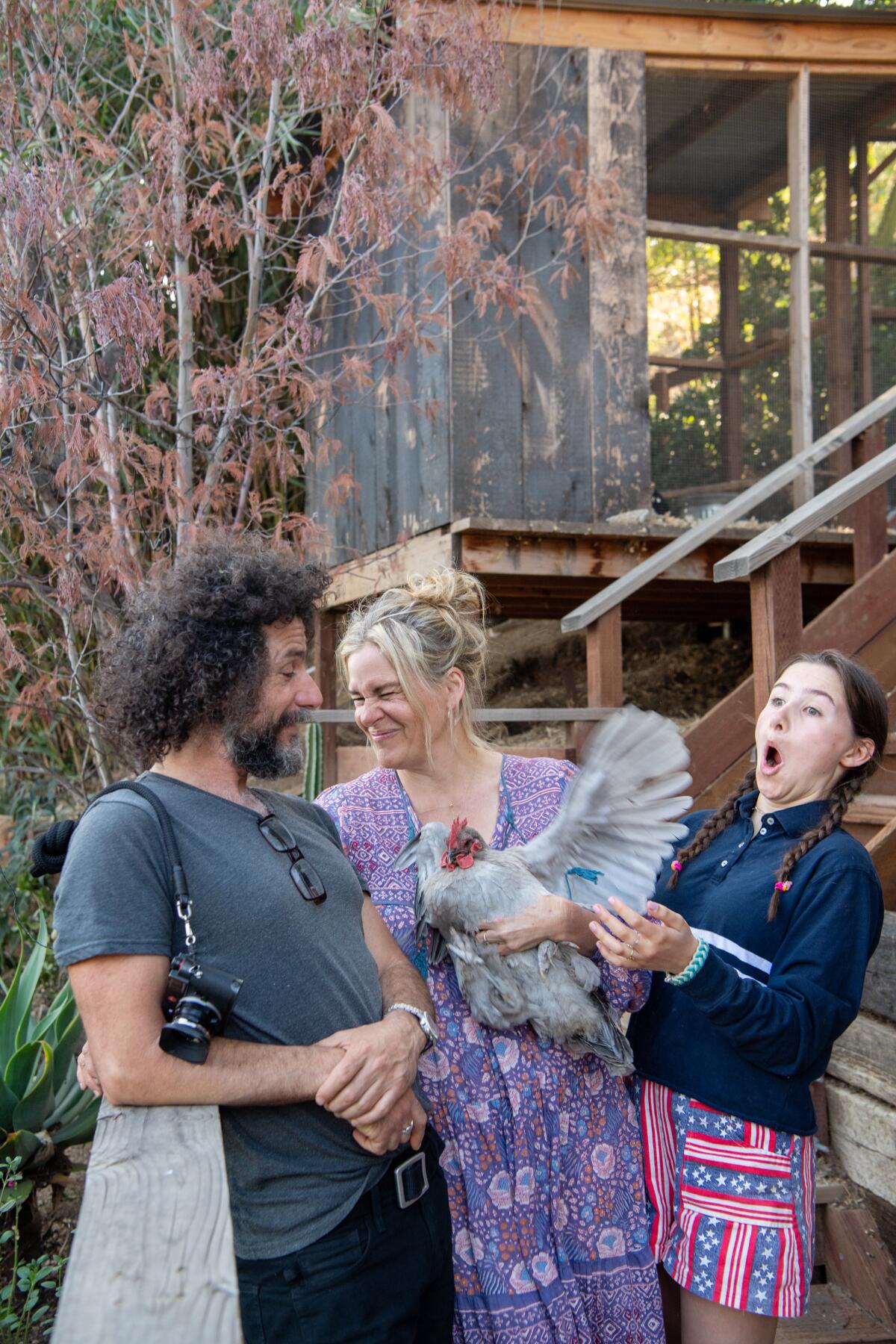
SHOU SUGI BAN
Lincoln Heights
When Ilse Ackermann describes herself as a “chicken consultant to the stars,” her tone is tongue-in-cheek. But she has the nondisclosure agreements to prove it. Her job, which involves 24-hour “fowl consultations” for anxious clients with broody birds, stems from her years living on Skyfarm, the urban farm she shares with her husband, photographer Meeno Peluce, their two daughters and 25 animals. She may design custom coops for Hollywood’s A-list, but her own is more modest, built of inexpensive wood and a galvanized roof from Home Depot that she estimates cost around $1,000. By contrast, the coop’s black charred exterior makes a statement in an orchard filled with colorful native plants and edibles. “I wanted to do it in shou sugi ban style because it is super chic and you don’t have to do anything to it,” Ackermann says of the ancient Japanese technique. “It’s great, because it is bug- and weather-resistant.” Before assembling the coop, Ackermann burned the wood in her driveway with a roofing torch. She then installed a wood floor — something she does not recommend — and assembled the structure from there. Outside the coop, she installed a compost bin for collecting chicken manure and a solar-powered radio to deter predators. (The continuous smooth jazz loop has had mixed results.) “When our first chicken died, we wept, and Meeno was inconsolable,” Ackermann says. “The last time one of our chickens was mauled by a coyote, there was blood everywhere, and we sewed her up with dental floss.” (Desperate, she consulted YouTube). The incident prompted Ackermann to order proper suture kits online. As for the chicken? It survived.
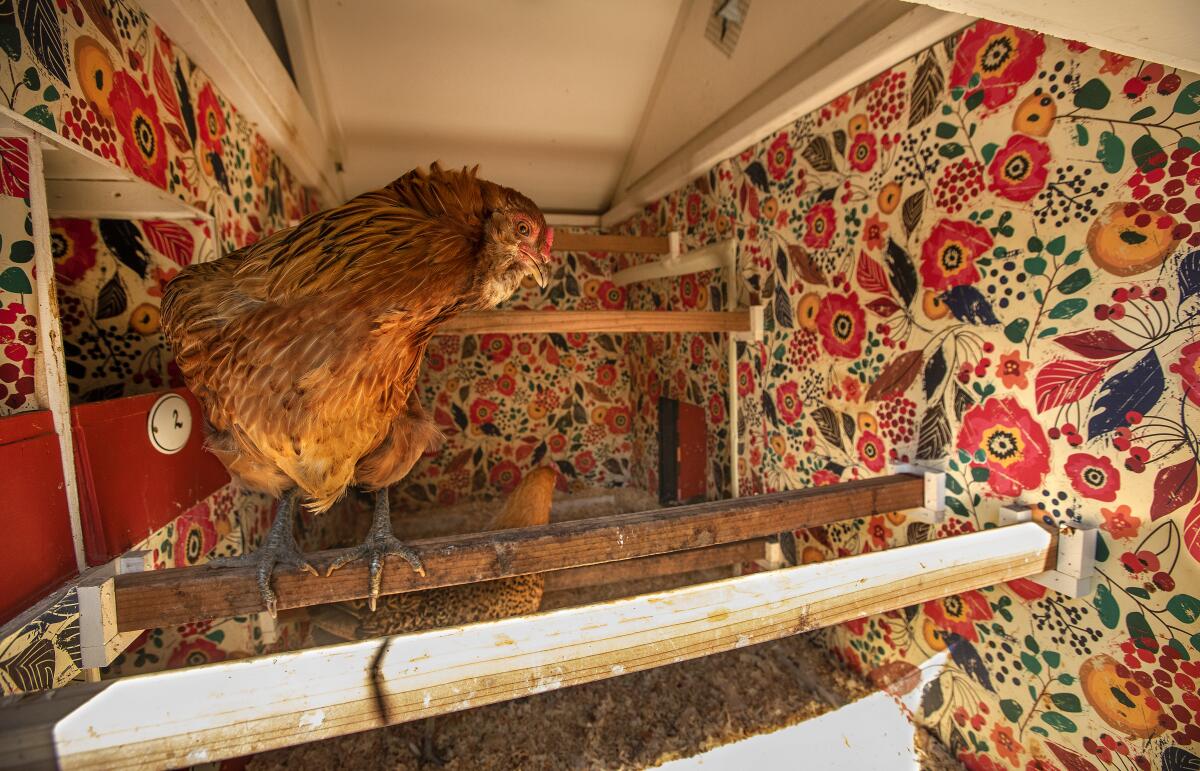
More to Read
Sign up for The Wild
We’ll help you find the best places to hike, bike and run, as well as the perfect silent spots for meditation and yoga.
You may occasionally receive promotional content from the Los Angeles Times.

